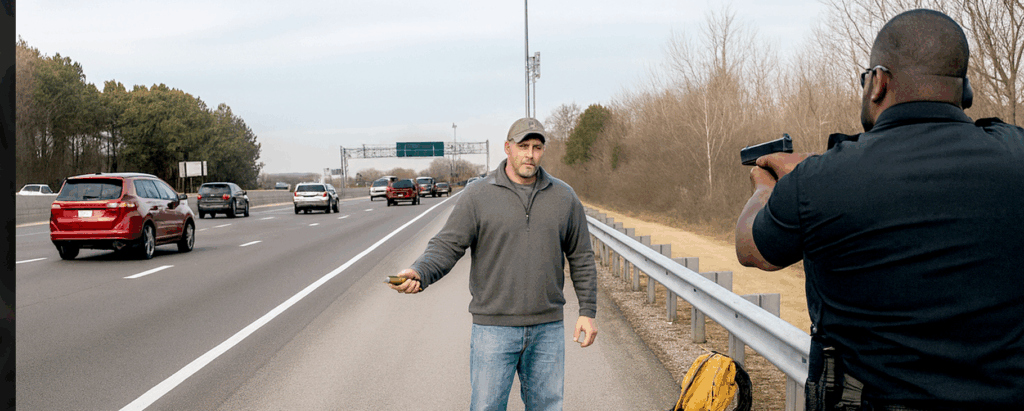Editor’s note: This article originally appeared in The Chief’s Chronicle; New York State Association of Chiefs of Police. Reprinted with permission.
Assume for a few moments that both of the following fact scenarios involve you. Consider how you would feel.
****
It is 10:00 pm and you and your fiancé are preparing for bed. Your fiancé’s sister is a person with mental illness and is staying in the apartment. You are happy, but also probably tired, because with you in your apartment is your one-week-old baby girl. You and your fiancé took her to her first doctor’s visit that day, and she received a clean bill of health.
EMTs arrive at your home and are let in by your fiancé’s sister. They tell you they need to check on the baby because of a 911 call from someone in the residence indicating the baby is being abused. Now you know the baby is not being abused and you know a doctor examined her that day and she is fine. You angrily tell the EMTs to get out and that no one there called 911. They leave. But then they come back with four officers who insist they must check on the baby.
This still does not make sense to you, so you step in front of the officers and tell them they cannot come in without a warrant. They respond by pushing into the apartment, forcing you to the ground and handcuffing you. You resist arrest out of frustration because the whole situation does not make any sense to you—you know there is no abuse, this is insulting, and you are angry because this is your home.
You are arrested, charged with obstructing governmental administration and resisting arrest; you spend the next two days in jail. Your daughter is checked out at the hospital and is diagnosed with a case of diaper rash. There was no evidence of abuse.
This discussion is not just about this one case and one fact pattern. What is described here is a process—a way of thinking when you have situations where a conflict of perspectives is possible.
****
It is approaching 10:00 pm and you and other officers meet up with two EMTs who advise you they attempted to follow up on 911 call about possible child abuse at an apartment. A woman who lives with the family told dispatchers she thought the baby’s father was abusing the baby because she saw a red rash on the baby’s behind.
The caller met the EMTs when they arrived and brought them into the apartment. The EMTs felt there was something wrong with the caller, that she was “strange” and “did not look like she was in her right mind.” Once in the apartment, they were confronted by the father. He was “aggressive” and told them no one called 911 and that they should leave, which they did. But they tell you they must go back to check the baby.
You hate these calls—all cops do, but the safety of the child is paramount. So, you all proceed to the apartment and knock on the door. The father opens it, and you tell him that you need to enter the apartment. But the father blocks the doorway, saying you cannot come in without a warrant. You feel you cannot take any chances with the welfare of a child, so you decide to push the issue and enter without his permission. As you cross the threshold the father blocks you and pushes you. Now all the officers rush in and take the father to the ground, handcuffing him.
The EMTs take the baby to the hospital, where she is diagnosed with diaper rash, but that is it. You agree with EMTs’ assessment; the 911 caller seems like she may have some type of mental dysfunction. But you are just a patrol cop and you are required to investigate alleged child abuse. You were doing your job and the father tried to prevent you. So now you must file the appropriate charges against him.
****
Who is right and who is wrong here? In my opinion, they each are both. What we have is a clash of perspectives, without either side considering the perspective of the other. The circumstances that brought them together were unfortunate and, with hindsight, unjust. The complaint was unfounded. But such things happen and will continue to occur. So, what can we learn from this incident?
Thompson v. Clark
These facts are drawn from the recent decision of the U.S. Supreme Court in Thompson v. Clark.[1] The incident and the arrest described in the two scenarios occurred on Jan. 15, 2014. Thompson was held in jail for two days and was then released on his own recognizance. At a subsequent court appearance, Thompson was offered an Adjournment in Contemplation of Dismissal. He rejected this offer, indicating he wanted to see the charge through to the end.
One month later, the charges against Thompson were dismissed “in the interests of justice.” There was, however, no reason stated for the dismissal in the court record, which would normally be required in such dismissals. In other words, while the charges were dismissed, there was no formal acknowledgment of Thompson’s innocence. This becomes a critical component of the ultimate decision by the Supreme Court.
Thompson then sued the city and multiple officers in federal court. The District Court denied most of the summary judgment and qualified immunity motions. The following claims were allowed to proceed to trial against various named officers:[2]
- Unlawful entry
- False arrest
- Excessive force
- Malicious prosecution
- Denial of right to a fair trial
- Failure to intervene
At trial, the jury found for the officers on all surviving claims. During the trial, the District Court applied two rules of law from Second Circuit precedent that favored the defendant officers. The first was the jury instruction pertaining to the existence of exigent circumstances. The general rule is that all warrantless searches are presumptively unreasonable. While there is a split in the law among the circuit courts, the Second Circuit places the burden of proof of non-exigency on the plaintiff, or the resident of the home intruded upon. In other words, the homeowner must prove there was no exigency, rather than the police proving there was.
What matters is that you at least attempt to step in the person’s shoes and patiently and respectfully explain why and how you need to proceed.
The second was the application of Second Circuit precedent requiring that any claim for malicious prosecution must be supported by proof of a finding of innocence. In an appeal by Thompson after the trial, the District Court reluctantly affirmed that both rules were supported by the prior decisions of the Second Circuit. But the District Court judge also opined that both rules should change because they place an unfair burden on a civilian plaintiff.[3] On appeal, the Second Circuit affirmed the District Court’s application of both rules during trial, and Thompson appealed to the Supreme Court.
The issue pertaining to the required elements of a malicious prosecution claim was the only one of the two issues that were presented, argued and decided by the Supreme Court in a 6–3 decision that would favor Thompson. The majority opinion recognized the split among the circuit courts of appeal in applying a malicious prosecution claim under 42 U.S.C § 1983. Some require some indication of innocence, while in others it is enough that the prosecution ended without a conviction.
The court first conducted a historical review of the original malicious prosecution tort law as it existed at the time of the enactment of § 1983. Ultimately, the majority held that malicious prosecution claims under § 1983 need only show that a prosecution ended without a conviction, with no affirmative indication of innocence required. Justice Kavanaugh, who wrote the majority opinion, emphasized that “Officers are still protected by the requirement that the plaintiff show the absence of probable cause and by qualified immunity.” The case was then remanded back to the Second Circuit for further proceedings.
Implications for Law Enforcement
After this decision was released, several headlines described how the Supreme Court had made it easier for people to sue the police. Some authors speculate the case could impact the decision-making of officers and prosecutors. While I am not a litigator, I do not see this decision as resulting in any significant detrimental impact on policing. Look back to the list of claims brought against the officers in just this one case. Each has its own elements that must be proved. Officers who make sensible and reasonable decisions, such as only making an arrest based upon probable cause, should not have anything additional to worry about. Lawsuits have always been and will continue to be a fact of life in police operations.
While the complex legal implications and issues of this case are important, and not fully developed here, that is not my primary takeaway. As a police trainer and risk manager, I see this case as another opportunity for self-examination and continuous improvement. I would rather look at the bigger picture of contemporary police operations than at legal intricacies that will not help an officer on the street.
In past trainings and articles, I have discussed some critical principles that apply to the discussion of this case. The first is the concept of legitimacy in decision-making, which I define as “legal but also the right thing to do.” In my opinion, legitimacy has three essential elements. The officer must have:
- A proper legal foundation
- Proper application of the priority of life of all involved
- Proper goals and objectives
The next concept pertains to officer attempts at de-escalation, or more appropriately, not escalating a situation. Specifically, citizen contacts need to be legitimate and based on respect. Officers must understand that to influence a person, you need to understand their perspective and purpose. This requires officers to place themselves in the shoes of the other person and treat the person how the officers would want to be treated under the circumstances. I was not there; I do not know exactly what happened, and I mean no disrespect to the officers involved. But I dug through as much material as I could access to determine the specifics of the interaction between the officers and Thompson at the door. It appears from the available facts that it was as simple as, “We are coming in.” “No, you are not.” “Yes, we are.” And that was that. The jury found in favor of the officers, but could the situation have been handled differently, with a better result?
What we have is a clash of perspectives, without either side considering the perspective of the other.
The final concept pertains to the importance of doing a root cause analysis of incidents. This one incident has spanned years, generated multiple court decisions, and cost who knows how much money and time for all the parties involved. But let’s cut to the chase—why did this happen? It happened because there was a clash of perspectives here that neither side took into consideration.
Obviously the initial 911 call was unfounded, placed from a person with mental illness who saw something that was not there. But these things happen, and officers cannot control that. This is important to understand when performing a root cause analysis in police-related incidents—the focus must be on what the officer can control, not what others do.
One could also point out that if Thompson had just respected the EMTs and officers and their reason for requesting entry, the incident would not have escalated. But that perspective misses the point about control—officers must understand that to control, or more appropriately, influence a person, officers must approach the person with respect and try to understand their perspective by considering what they would feel in such a situation. Think how you felt reading the first fact pattern in this article. If this were you, you would know you did nothing wrong and know the baby is fine.
So where is this going? How and what do we learn from this case? First, when you have discretionary time, as the officers did here, legitimacy would require you think things through on your way to the call and discuss it with other officers. What will your legal standing be? For this case, we have a call from a person who the EMTs felt “did not appear to be in her right mind.” You also have a good idea from the EMTs that Thompson was not cooperative. Does this support a warrantless entry based on exigent circumstances? Maybe, maybe not. You have a valid goal in ensuring the safety of the child, but that is not a substitute for the credibility of the source of information. Also, forcing entry will, from a priority-of-life perspective, place not only Thompson but the officers at risk as well.
All these principles could lead to a more reasonable course of action: Officers knock and then attempt to patiently explain why they are there, while acknowledging Thompson’s perspective. I could go on with other suggestions, but it does not matter what I would do. What matters is that you at least attempt to step in the person’s shoes and patiently and respectfully explain why and how you need to proceed. Maybe it will not make a difference and maybe a person like Thompson would still resist no matter what the officers did. But the difference is that you tried and, by doing so, placed yourself in a much better position with the satisfaction of knowing you did all you could do to handle the situation in a professional manner.
Remember, this discussion is not just about this one case and one fact pattern. What is described here is a process—a way of thinking when you have situations where a conflict of perspectives is possible. As District Court Judge Weinstein stated in his decision, “What shall a ‘good citizen,’ or a ‘good police officer,’ do when the United States Constitution tells them one thing and their common sense another?”[4]
References
- 142 S.Ct. 1332 (April 4th, 2022). The factual depictions in this article were drawn from the Supreme Court Case, and two prior United States District Court cases: Thompson v. Clark, 2018 WL 3128975 (E.D.N.Y. 06/26/2018) and Thompson v. Clark, 364 F.Supp.3d 178 (E.D.N.Y. 03/12/2019) (this latter case was decided after the jury trial). When courts prepare opinions, they may recite whatever facts they feel are important. In cases such as this, and for the purposes of this article, I needed to dig back into the prior decisions to extract as many facts as possible.
- Clark, 2018 WL 3128975 (E.D.N.Y. 06/26/2018)
- Clark, 364 F.Supp.3d 178 (E.D.N.Y. 03/12/2019), affirmed 794 Fed. Appx. 140 (2nd Circuit 2020).
- Clark, 2018 WL 3128975, I. Introduction
[strategem_author]



